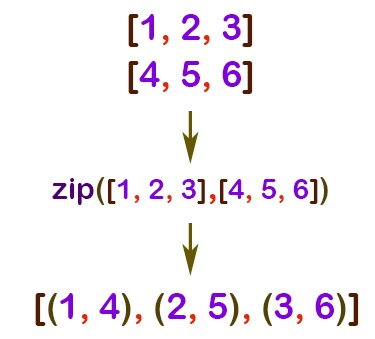Beginner’s Guide to the zip() function in Python3
- 时间:2020-09-21 09:15:21
- 分类:网络文摘
- 阅读:110 次
The zip function in Python 3 takes two parameters, and generate an iterator that contains tuples. Each tuple takes a value from each input – which can be tuples or arrays. It can be illustrated as follows:

python3-zip-function
Python3 zipping two tuples
In Python2, the zip function will return all the zipped-elements in an array while in Python3, the zip function will returns an iterator – saving memory. For example,
1 2 3 4 | a = (1, 2, 3) b = (4, 5, 6) zip(a, b) # <zip object at 0x7ff81cb770c8> list(zip(a, b)) # [(1, 4), (2, 5), (3, 6)] |
a = (1, 2, 3) b = (4, 5, 6) zip(a, b) # <zip object at 0x7ff81cb770c8> list(zip(a, b)) # [(1, 4), (2, 5), (3, 6)]
As you can see in this example, the source inputs can be tuples as well. You can mix-and-match and the result is always an iterator. Then you can easily convert the iterator to array using list() or to set using the set().
zipping takes minimal length
If both inputs are of different sizes, the zip function will only zip the minimal length of both. For example,
1 2 3 4 | a = (1, 2, 3, 4) b = (4, 5, 6) zip(a, b) # <zip object at 0x7abcdcb770c8> set(zip(a, b)) # {(1, 4), (2, 5), (3, 6)} |
a = (1, 2, 3, 4)
b = (4, 5, 6)
zip(a, b) # <zip object at 0x7abcdcb770c8>
set(zip(a, b)) # {(1, 4), (2, 5), (3, 6)}zip nested elements
The zip function can take nested inputs as well, for example:
1 2 3 | a=[(1,2),(3,4)] b=[(5,6),(7,8)] list(zip(a,b)) # produces [((1, 2), (5, 6)), ((3, 4), (7, 8))] |
a=[(1,2),(3,4)] b=[(5,6),(7,8)] list(zip(a,b)) # produces [((1, 2), (5, 6)), ((3, 4), (7, 8))]
You can use the zip() function to achieve something similar of what the enumerate() does in Python.
–EOF (The Ultimate Computing & Technology Blog) —
推荐阅读:大量生吃皮蛋,小心“烧”伤口腔 食品安全绕不开的食品添加剂问题 没有食品添加剂,我们的生活会怎样? 黑豆补气抗衰老 黑色食品有保健奇效 蜂蜜是冬天补养佳品 滋阴润燥的食物 冬季饮食10个注意 饮食搭配有原则 秋冬进补忌选狗肉 不可不知的进补攻略 养生又保健:柚子皮的神奇做法 选择有机食品真的更有营养吗? 回顾2012年发生的八大食品安全事件
- 评论列表
-
- 添加评论